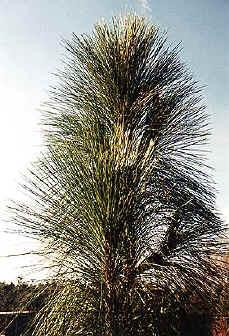
Pinus palustris -- Pearson Creek
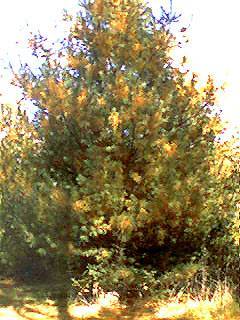
Pinus strobus shedding
2 year leaves
("gymnosperm fall colors")
-- Pearson Creek
"I think that I shall never see a poem as lovely as a tree." -- Joyce Kilmer, Trees
Pine Leaves ("Needles")

Pinus palustris -- Pearson Creek |
 Pinus strobus shedding 2 year leaves ("gymnosperm fall colors") -- Pearson Creek |
The typical needle-shaped leaf is found in all species of the Pinaceae family and it is the arrangement of these needles in bundles or fascicles that is the most characteristic feature of the genus Pinus. In some pines, e.g., P. strobus or P. palustris, the needle is shed after the second growing season, but in most species they persist longer and in the extreme, up to 36 years in P. longaeva.
Actually pines have three kinds of leaves. The first appear after the seed germinates and are called cotyledons or "seed leaves." These are small soft needle-shaped leaves and their number varies from 3 or more (P. contorta, banksiana and sylvestris) to eighteen or more (P. lambertiana, sabiniana and maximartinezii). As soon as the emerge, they are capable of respiration and photosynthesis. Shortly after the cotyledons come the juvenile leaves which are shaped like the cotyledons and are solitary and arranged in a spiral. These are usually shed in several weeks after the adult leaves, which have basal sheath and fascicular arrangement characteristic of the genus pinus, make their appearance.
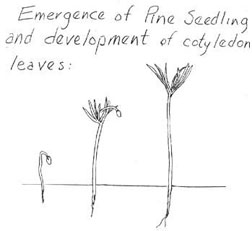
The outer layer of the adult leaf is the waxy cuticle which protects the leaf from drying. In the cuticle are minute openings known as stomata and these permit the movement of carbon dioxide into and oxygen from the leaf. In most haploxylon pines the stomata are on the ventral (lower) surfaces and the diploxylon pines have stomata on both ventral and dorsal surfaces. These stomata often form fine white streaks running along the length of the leaf. The leaves of the diploxylon pines are generally stiffer and arranged in fascicles of 2 or 3 needles(sometimes more) and the haploxylon pines usually have softer needles in fascicles of 5 needles(sometimes less). The basal sheath of diploxylon pines lasts for the life of the leaf whereas the basal sheath of the haploxylon pines is soon shed or, in the case of the pinyon and foxtail-bristlecone group (Section Parrya), it curves back to form a "rosette."
The internal structure of the leaf is complex and includes a photosynthesizing parenchyma ("chlorenchyma" or mesophyll) and resin canals which may be located just beneath the cuticle (often in the haploxlon pines) or varyingly deeper within the needle (often in the diploxylon pines). Centrally there are fibrovascular bundles, which form the basis of classification of the genus pinus into the subgenera Strobus ( the"soft" or "white" pines) with one (haploxylon) fibrovascular bundle and Pinus (the "hard" or "yellow" pines) with two (diploxylon) fibrovascular bundles.** The resin canals connect with the stomata are involved in gas exchange and the fibrovascular bundles connect ultimately with the xylem involved with the transport of nutrients, sugars and water between the top of the tree and the roots.
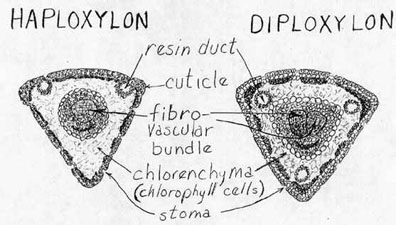
**In this file the subgenera names Haployxlon (a.k.a. Strobus) and Diploxylon (a.k.a. Pinus) are used because they describe the essential difference between the two.
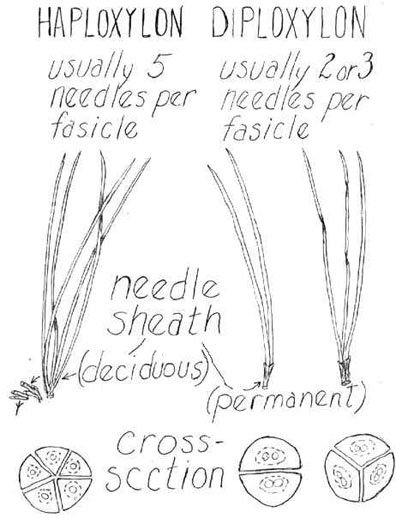
|
|
Haploxylon (Strobus)subgenus sheaths are
deciduous;
Diploxylon (Pinus) subgenus sheaths are permanent
(usually).